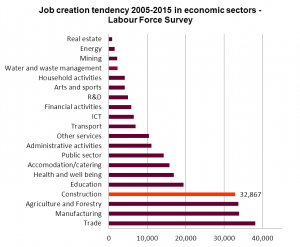The Kosovo labour market demand for construction and infrastructure professionals has been particularly high in recent years. Based on a recent study of higher education graduate demand in economic and skill sectors (EC/LSE, 2015) in Western Balkans and Kosovo, construction and infrastructure technicians and professionals is one of the most dynamic occupations in employment growth in Kosovo. The construction and infrastructure sector captures nearly 20 percent of annual economic activity in Kosovo and in recent years has been the key source of growth and income generation. The high demand for civil engineering, construction and infrastructure has been very high due to increased government spending (5.5% of GDP, circa 260 million Euro), foreign direct investment (IMF, 2015) and private investments. The construction boom has not lost any pace since the post-war reconstruction phase. In order to meet the existing market demand Kosovo will need in the next years some 60,000 new apartments including infrastructure, roads, kindergardens and schools.
Construction and Infrastructure is one of the main pillars of the newly adopted Kosovo National Development Plan. The plan stresses the need for improved regulatory framework, investments and human capital creation in the sector. As part of the human capital creation, the plan calls on education institution to play a more active role in both increasing the share of students enrolled in related programs but also pay greater attention to specialist studies to advance the knowledge base. Another factor that is helping to boost the demand for skills is the road construction. The government of Kosovo has set to connect the country from several directions: Albania, Macedonia and Serbia. Highway construction and rural development infrastructure will stimulate the economic sector and create additional demand for labour. Another important factor is the EU-funded development aid which will be oriented towards railway and rural development infrastructure (IPA, 2015).
UBT on the other hand uses an indicator framework to assess demand for professionals and economic sectors.
The indicator framework is composed of:
- 1) skill sectors employing most of professionals (to differentiate among all workers in the sector),
- Share of professionals’ distribution in all economic sectors (ISCO) ;
- Job creation tendency in the past decade for the respective economic sector (NACE).
According to Kosovo Labour Force Survey (2015), the economic sectors with the highest share of employment and job creation are trade, manufacturing and construction. Adjusting to changing demands is usually rooted in knowledge used for civil engineering and construction projects in a thriving local and international market. Kosovo civil engineers and construction professionals have found employment and opportunities beyond Kosovo, namely Albania, Macedonia, Montenegro, Turkey , Middle East and Asia. If the know-how is created at education institutions in close interaction with industry, the competitive advantage build on cheap labour may position professionals and firms in the sector in terms of better income, employment and overall social welfare. Therefore, domestic knowledge growth and development are key to gain and retain competitiveness. Based on the job creation indicator, construction and infrastructure rate among the top performing and job creation industries.

In summary, on the basis of Labour Force Survey construction, civil engineering and infrastructure are the skill areas employing the highest share of professionals. The the sector has created around 31,867 jobs in the past decade and according to economic projections another 10,000 new jobs will be created until 2025 (USAID, 2014). About 36 percent of jobs created in the sector related to higher professional and technical skills.